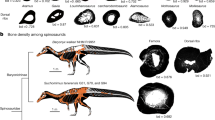Abstract
Evidence, amongst Triassic thecodonts, of energetic upright postures and advanced bipedalism (or the vestiges of such characteristics) reveals that both endothermic and ectothermic thecodonts were descended from warm-blooded archosaurs with rapid metabolisms. Arboreal and aquatic adaptations in bipedal iguanians, and in extinct thecodonts, suggest that the emergence of reptilian bipedal locomotion is related to an arboreal-aquatic existence. But endothermy-required obligatory bipedalism could not have arisen in fauna-poor freshwater environments. The possible existence, in faunivorous thecodonts, of functional (or vestigial) cranial salt glands may suggest that the earliest semiaquatic archosaurs originated in fauna-prolific marine environments. If archosaurs were originally semiaquatic (marine) predators, then the existence of archosaurian endothermy could have initially emerged as an adaptation to increase metabolic heat production under the enhanced thermal cold stresses of the marine hydrosphere, while concurrently augmenting the rate of metabolic water production within saltwater environments inherently lacking in palatable freshwater resources.
Similar content being viewed by others
References
Baker, R.T. (1975) Dinosaur renaissance, Scientific American, 232(4), 58-78.
Desmond, A.J. (1976) The Hot-Blooded Dinosaurs, New York: The Dial Press/James Wade.
Baker, R.T. (1980) Need for endothermic archosaurs. In R.D.K. Thomas and E.C. Olson (eds) A Cold Look at the Warm-Blooded Dinosaurs, pp. 351-462. Boulder: Westview Press.
Ostrom, J.H. (1980) The evidence for endothermy in dinosaurs. In R.D.K. Thomas and E.C. Olson (ed.) A Cold Look at the Warm-Blooded Dinosaurs, pp. 15-54. Boulder: Westview Press.
Baker, R.T. (1986) The Dinosaur Heresies, New York: William Morrow and Company.
Romer, A.S. (1966) Paleontology, Chicago: The University of Chicago Press.
Benton, M.J. (1990) Origin and interrelationships of dinosaurs, In D.B. Weishampel, P. Dodson and H. Osmolska (eds) The Dinosauria, pp. 11-30. Berkeley: University of California Press.
Walker, A.D. (1972) New light on the origin of birds and crocodiles. Nature 237, 257-63.
Dunson, W.A. (1976) Salt glands in reptiles. In C. Gans and W.R. Dawson (coed.) Biology of the Reptilia, Volume 5, pp. 413-445. London: Academic Press.
Halstead, L.B. and Halstead, J. (1981) Dinosaurs, Poole, Dorset: Blandford Press.
Benton, M.J. (1982) The diapsida: revolution in reptile relationships. Nature 296, 306-307.
Charig, A. (1983) A New Look at the Dinosaurs, New York: Facts on File.
Milne, A. (1991) The Fate of the Dinosaurs, Great Britain: Prism Press.
McFarland, W.N. (1979) Vertebrate Life, New York: Macmillian Publications.
Neill, W.T. (1971) The Last of the Ruling Reptiles, New York: Columbia University Press.
Mayhew, W.W. (1968) Biology of desert amphibians and reptiles. In G.W. Brown (ed.) Desert Biology, Volume 1, pp. 196-299. New York: Academic Press.
Goin, C.J., Goin, O.B. and Zug, G.R. (1978) Introduction to Herpetology, San Francisco: W.H. Freeman and Company.
Colbert, E.H. (1961) Dinosaurs: Their Discovery and Their World, New York: Dutton.
Olshevsky, G. (1994) The birds first? A theory to fit the facts. Omni 16(9), 34-86.
Norman, D. (1994) Prehistoric Life: The Rise of the Vertebrates, New York: Macmillan.
Chatterjee, S. (1982) Phylogeny and classification of thecodontian reptiles. Nature 295, 317-20.
Coombs, W.P. (1980) Swimming ability of carnivorous dinosaurs. Science 207, 1198-1200.
Dixon, D., Cox, B., Savage, R.J.G. and Gardiner, B. (1988) Dinosaurs and Prehistoric Animals, New York: Macmillan Publishing Company.
Paul, G.S. (1988) Predatory Dinosaurs of the World, New York: Simon and Schuster.
Carroll, R.L. (1976) Eosuchians and the origin of archosaurs. In C.S. Churcher (ed.) Athlon.Roy., pp. 58-79. Toronto: Ontario Museum.
Hotton III, N. (1980) An alternative to dinosaur endothermy: the happy wanderers. In D.K. Thomas and E.C. Olson (eds) A Cold Look at the Warm-Blooded Dinosaurs. pp. 311-45. Boulder: Westview Press.
Regal, P.J. and Gans, C. (1980) The revolution in thermal physiology: implications for dinosaurs. In D.K. Thomas and C.O. Everett (eds) A Cold Look at the Warm-Blooded Dinosaurs, pp. 167-88. Boulder: Westview Press.
Kenyon, K.W. (1975) The Sea Otter in the Eastern Pacific Ocean, New York: Dover Publications.
Schmidt-Nielsen, K. and Fange, R. (1958) Salt glands in marine reptiles. Nature 182, 783-85.
Schmidt-Nielsen, K. (1959) Salt glands. Scientific American January.
Alexander, R.M. (1975) The Chordates, London: Cambridge University Press.
Vaughan, T.A. (1978) Mammology, Philadelphia: Saunders College Publishing.
Morgan, E. (1982) The Aquatic Ape, New York: Stein and Day Publishers.
Irving, L. (1969) Temperature regulation in marine mammals. In H.T. Andersen (ed.) The Biology of Marine Mammals, pp. 147-74. New York: Academic Press.
Grollman, S. (1974) The Human Body: Its Structure and Physiology, New York: Macmillan Publishing Co.
Scheffer, V.B. (1976) A Natural History of Marine Mammals, Charles Scribner's.
Bonner, W.N. (1994) Seals and Sea Lions of the World, New York: Facts on File.
Author information
Authors and Affiliations
Rights and permissions
About this article
Cite this article
Williams, M.F. The adaptive significance of endothermy and salt excretion amongst the earliest archosaurs. Speculations in Science and Technology 20, 237–247 (1997). https://doi.org/10.1023/A:1026415406954
Issue Date:
DOI: https://doi.org/10.1023/A:1026415406954




